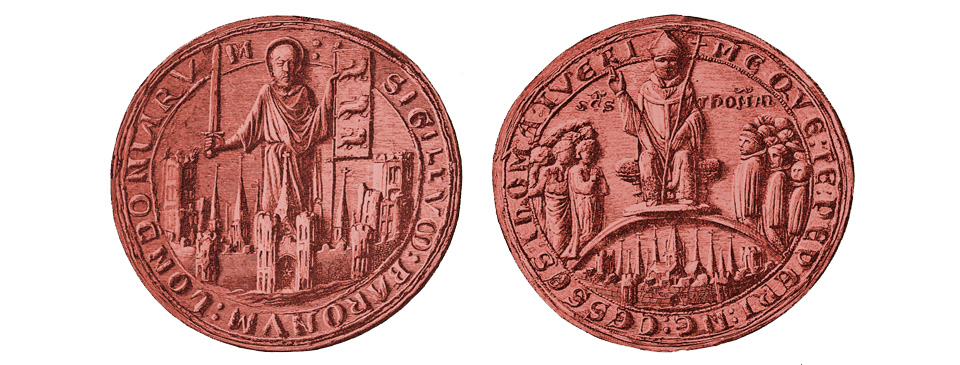In Brief – London in the early-Middle Ages

The early 13th century seal of the City of London. On the right is Thomas á Becket and on the left St. Paul defending London.
Richard I (‘the Lionheart’) was a largely absent king who visited England only twice as monarch, totalling just six months, leaving the governance of the country to (initially) unpopular lieutenants based at the Tower of London. After being stripped by his brother of his inheritance, Prince John Lackland gained the support of some of the most influential barons and laid siege to the Tower. In order to win over its leading citizens John negotiated and agreed a certain degree of independence and self-government for London, including the right to elect its own leader, known as a ‘mayor’, a position that began to take seniority over the sheriff. When he finally inherited the crown King John had disagreements with the barons, leading to the creation of the Magna Carta in 1215.
Issues between John’s successor, Henry III, and the barons led to civil war between 1262 and 1264 and the creation by the barons of governance by committee, based at Westminster and known as the ‘Parliament’. Although it was short-lived it became the foundation of our modern democracy. During much of Henry’s reign he had a poor relationship with London.
In the late 1250s there were several years of poor weather and crop failures that led to thousands of deaths in London from starvation or other reasons. Around twenty five percent of the city’s population died and at least one mass grave was created, at Spitalfields. At the time it was assumed to be some form of plague and perhaps a punishment from God but the cause has since been identified as a massive volcanic eruption, probably in Central or South America.
To the west of London, Westminster Abbey grew in status throughout the medieval period. From the time of King Harold and William I it was where almost all coronations of English monarchs took place. King Edward (“the Confessor”) had been buried in his mighty abbey in 1066 and during the 12th century its abbots ensured his canonisation by forging documents and exaggerating ‘miracles’, thus ensuring the abbey became a prestigious place of pilgrimage. In order to underline that he was descended from a saint, Henry III had a magnificent tomb created for Edward in the monastery. In 1243 he initiated the transformation of the abbey from the previous Romanesque building to the Gothic style that remains today. It was a vast undertaking that was not completed until the 16th century.
One of the consequences of Magna Carta was that the civil courts were established in the Great Hall at Westminster and it led to a high concentration of lawyers and law students living between there and the west side of the city. When Henry III established schools at Oxford he banned the teaching of law within London. Lawyers responded by leasing premises between London and Westminster that created the various Inns of Court that continue today.
With thanks to Ursula Jeffries for help with fact-checking and proof-reading.
< Go back to In Brief: Saxons, Vikings, Normans or forward to In Brief: London in the Late Middle Ages >


